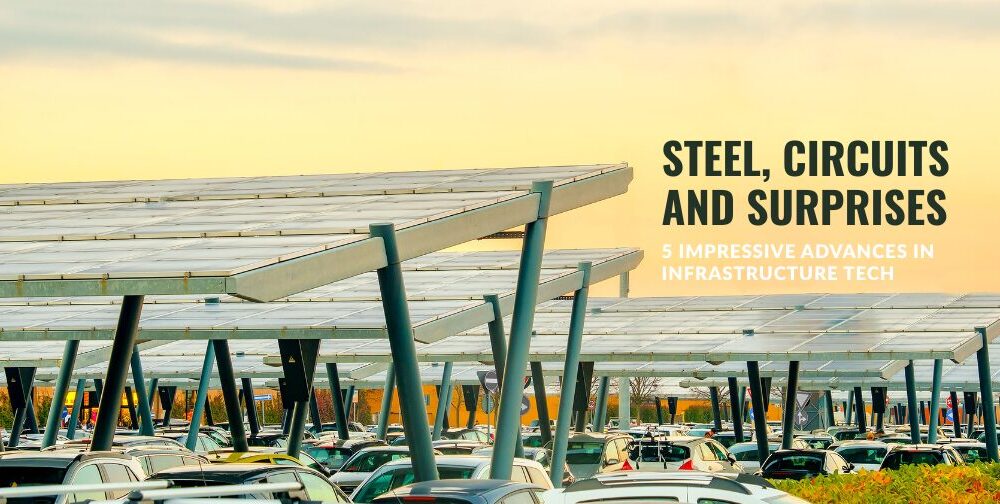Steel, Circuits and Surprises: 5 Impressive Advances in Infrastructure Tech

Technology is the great equalizer in infrastructure development. Adopting the latest innovations enables countries, states and towns to make a quantum leap, improve millions of lives and revolutionize societies over the long term. Here are five infratech advancements shaping the world’s future.
1) Metal Additive Manufacturing (MAM)
MAM is one of the advanced manufacturing technologies that will build and maintain tomorrow’s infrastructures. It can fabricate lightweight structural components with complex geometries, reducing transportation-related costs and greenhouse gas emissions and accelerating project completion times. Metal 3D printers can help build structures from scratch and supercharge repairs through rapid prototyping and on-demand remanufacturing.
Only some materials are suitable for use in MAM. Examples include aluminum alloys, cobalt-base alloys, nickel-base alloys and stainless steels. Additionally, wire offers a broader range of material options than metal powder as a source of feedstock. However, using wire as a source of feedstock limits output to more straightforward designs.
Research and development don’t stop in this promising domain. The brightest materials engineers can iron out the kinks and develop cutting-edge feedstock to incorporate smart infrastructure elements that adapt to ever-changing conditions.
2) Wireless Charging Roads
Electric roads play a vital role in promoting zero-emission motoring and autonomous mobility.
Inductive charging relies on electromagnetic fields to transfer solar energy from the coils embedded in roadways to the batteries of EVs traversing them. Conductive charging requires EVs to physically touch an electrified rail or overhead wire to recharge as they go. Either method reduces the need to stop after every 200 miles to ensure EVs don’t drain during trips.
China, the global leader in electric mobility, has unveiled wireless charging roads in Shandong and Jilin provinces in recent years. Detroit is the host of the first of these highways on American soil. France aims to build 5,500 miles of electrified roads using inductive charging, rail or overhead cables by 2035.
3) Solar Canopies
These elegant coverings generate green electricity and provide shade, maximizing the sun’s free energy and mitigating unwanted infrared and ultraviolet radiation.
Solar canopies are perfect for organizations with ambitious environmental, social and governance goals, as they contribute to numerous sustainability initiatives, especially net-zero targets.
These aesthetically pleasing structures are instrumental in achieving net-zero targets because they feed solar-generated power to the grid to offset energy usage. They lower the adjacent facilities’ cooling loads by shading walkways and parking areas, alleviating the heat island effect. These durable canopies minimize waste by protecting valuable assets like automobiles from hailstorms and other destructive weather events.
4) AI-Powered Digital Twins
Marrying digital twins with AI paves the way for sound urban planning. AI algorithms can power simulations to demonstrate various developmental scenarios through virtual models of towns. They allow government agencies and private organizations to foresee the planned projects’ positive and negative impacts before implementation.
Leveraging both technologies reduces blind spots, avoids costly trial and error, informs decision-making, and conserves resources.
AI-powered digital twins enable predictive infrastructure management. AI models can analyze data collected by different sources — including IoT sensors integrated into infrastructures — to monitor asset condition in real time, predict failure and perform maintenance tasks proactively.
5) Blockchain
This technology can facilitate activities throughout the infrastructure life cycle with transparency, security and efficiency. Blockchains are decentralized, promoting collaboration and streamlining information sharing between relevant stakeholders. They store data and record immutable digital trails, which help track materials and review documents.
These distributed ledgers can automate transaction execution through smart contracts. Meeting predetermined conditions triggers these automated transactions, incentivizing all parties involved to behave accordingly.
Blockchain technology enables tokenization, which creates digital representations of infrastructure asset ownership units. Tokenized physical assets can unlock new ways to make illiquid assets more liquid, attract investors and secure financing to raise capital.
Celebrating the Latest Infratech Innovations
Recognizing the value of these exciting technologies is one thing, but embracing them is another. Hopefully, key infrastructure players can find ways to overcome barriers to adoption to maximize these infratech solutions sooner rather than later.



